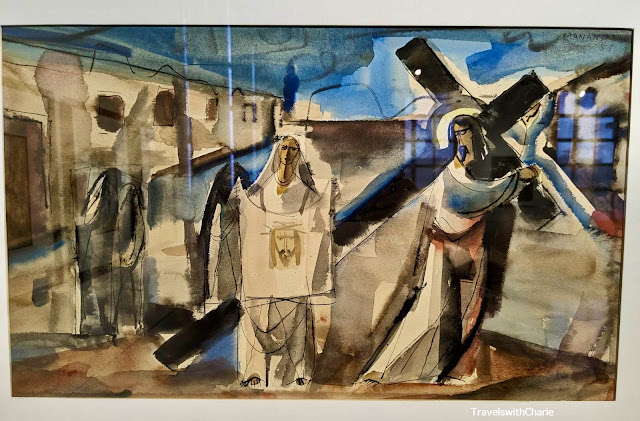I Believe in God, 1948, oil on masonite
One of the group of Thirteen Moderns and Neo Realists, Vicente Silva Manansala had the good fortune to study art in Canada, the United States, France and Switzerland through a number of grants he received from UNESCO, the French government and the U.S. State Department. He studied at the Ecole de Beaux Arts in 1950 under the mentorship of Fernand Léger, a renowned French artist and exponent of cubism.
Manansala’s early works were influenced by Fernando Amorsolo whose paintings celebrated Philippine landscapes and local culture. Manansala’s oeuvres portray the working class like the fish and candle vendors, the man with the rooster, or the family praying together (above image). I believe in God is a painting completed by Manansala before he dabbled into cubism. The figures and forms are solid depictions of farmers in the rural landscape.
Procession, 1948, oil on canvas
1948 was three years after the second world war. The Philippines was quite devastated and the people were reeling from the death and destruction of war. They were putting their lives back together. Procession presents a somber scene with people dressed primarily in black and walking with bent heads.
Here’s another somber scene of the Filipino rural landscape. Perhaps it is the destination of the Procession. The weight of pain and sorrow in burying a family member or friend is echoed on the backs of the men on the scene. Unfortunately, it’s barely discernible in this photo because of the glare from overhead lighting.
Man and Rooster, 1950, oil on canvas
Two years after I believe in God was painted, we see a stark change in the style of Manansala. In 1950, he was awarded a nine month scholarship in France where he was introduced to cubism. In order to understand the influence of cubism in the artist’s works, it helps to know a little bit about this particular art movement pioneered by Pablo Picasso and Georges Braque in the early 1900s. There are two stages of cubism, analytical and synthetic. Analytical cubism is characterised by fragmentary forms with multiple viewpoints and overlapping planes while employing a limited palette. Synthetic cubism emerged in 1912 and is defined by the flattening of images and the application of a brighter range of colors as you can observe in Man and Rooster.Manansala studied stained glass art in the United States in 1960 through a Specialist grant from the US Department of State. Making stained glass requires several steps including shaping and cutting glass, painting, glazing, connecting all the pieces together and fastening them with lead. Man and Rooster has the quality of stained glass with precise planes and defined lines. There is an illusion of light filtering through the paintings with the application of brilliant colors (especially yellow) just like the rays of the sun penetrating stained glass windows in darkened, medieval cathedrals.
Birds in Flight, 1965, oil on canvas
Here’s another example of a painting by the artist that reflects Cubist characteristics. Birds emerge from the flat and overlapping shapes and are poised for flight. The black and white floor tiles below give depth to the painting.
Fish Vendor, 1954, mixed media on masonite
In this painting, the faces of the vendors are rendered in flat planes further amplified by the square shaped head covers.
Intl. Rice Research Institute (IRRI) Series, oil on canvas, 1962
These two large scale paintings (above and Masaganang Ani, below) were commissioned by the IRRI for their headquarters in Los Baños, Laguna in 1962. These works depict Filipinos at play and at work. The painting above portrays the game of sipa (kickball) on the left, a cockfight, and a carabao race on the right.
Masaganang Ani, oil on canvas, 1962
Masaganang Ani means a bountiful harvest. In this painting we see fishermen hauling in their catch (left) and on the right, farmers are collecting palay (rice) from the field. On center stage is a mother bathing her child. these two paintings have been designated National Cultural Treasures by the National Museum of the Philippines where it is currently on display. Please check back later for my article about these two masterpieces which will include close up photos of sections of the paintings.
Study for Man and Industry, 1962, tempera, watercolor and collage on paper
Christie’s (who listed a similar work) named Manansala as “one of the best watercolorists in the Philippines after Carlos Francisco”.
Abstract Nude, 1950, charcoal on paper
Before Manansala was “discovered” by art collectors, he worked as an illustrator for Philippines Herald and Liwayway magazine. As an illustrator he received a steady income while the work experience honed his drawing skills, sharpened his eye for details, and developed his painting skills.
Calesa, 1951, watercolor on paper
Veronica, 1957, watercolor on paper
Bayanihan, 1979, oil on jute
Bayanihan means a sense of community. The word is derived from bayan which means town or country or community. In this painting, several men are lifting a heavy load on their shoulders, probably a nipa hut. The idea of helping one another in the community exemplifies the Bayanihan spirit.
Vicente Silva Manansala was posthumously awarded the National Artist for Painting Award in 1981.
To learn more about Manansala’s Philippine Village Life from the PhilAm Life Collection follow this link: https://www.travelswithcharie.com/2020/08/the-philippine-village-life-by-vicente.html
The IRRI paintings: https://www.travelswithcharie.com/2025/01/masaganang-ani-by-vicente-silva.html
National Museum of Fine Arts of the Philippines
Padre Burgos Avenue, Rizal Park, Manila
nationalmuseum.gov.ph
Entrance to the museum is free.
Images by TravelswithCharie













